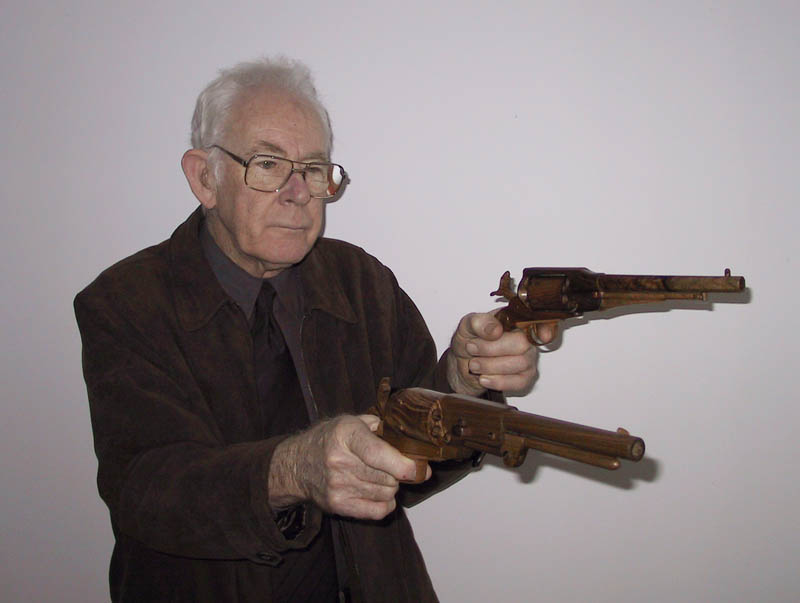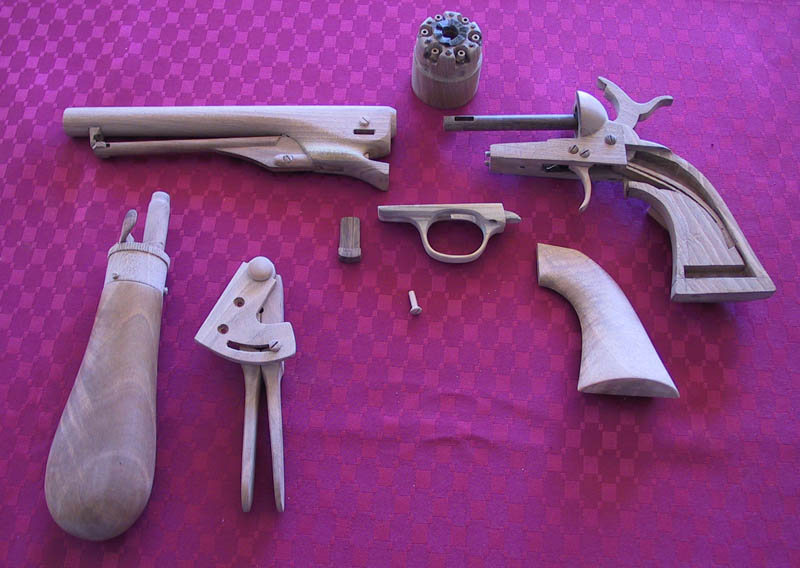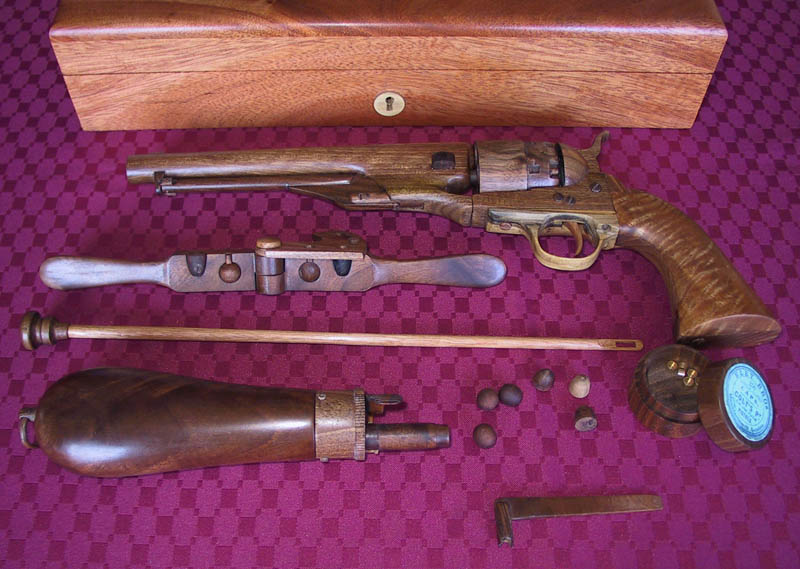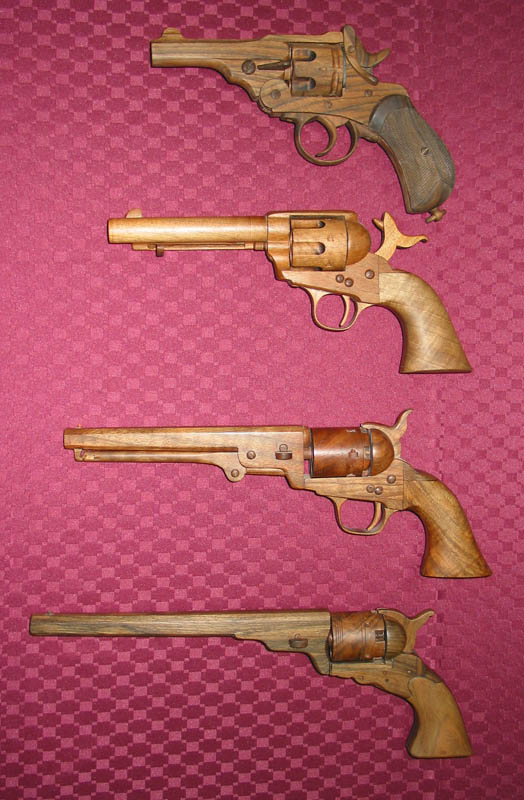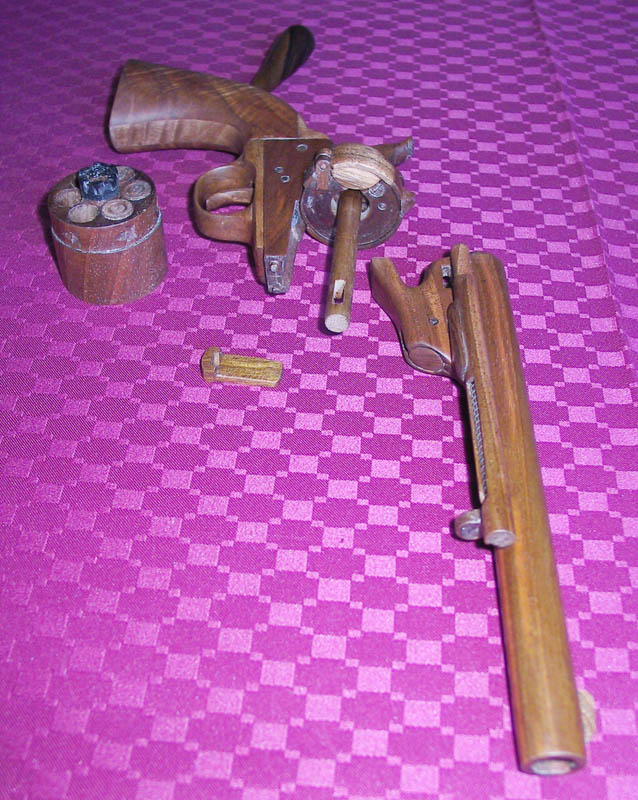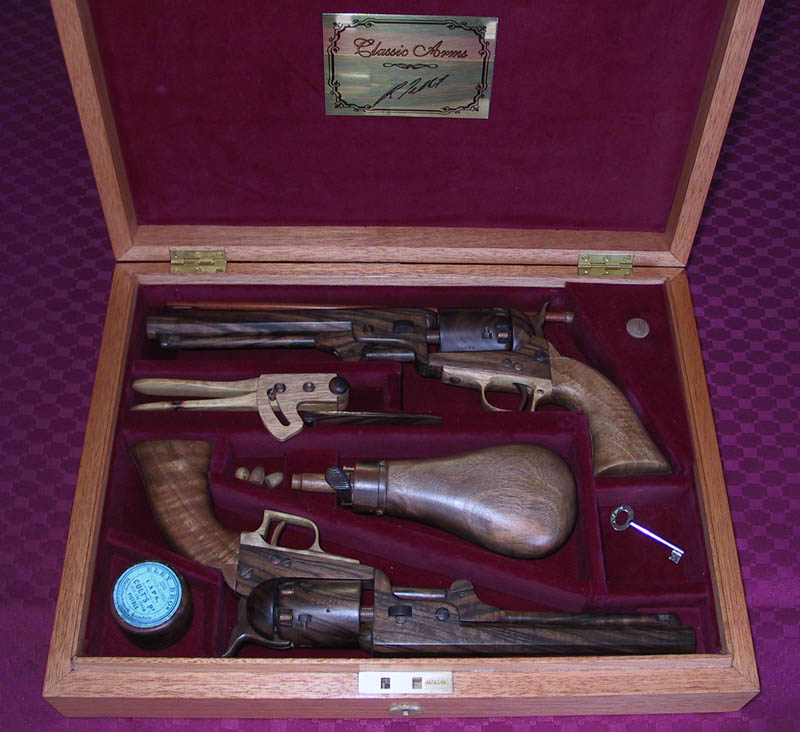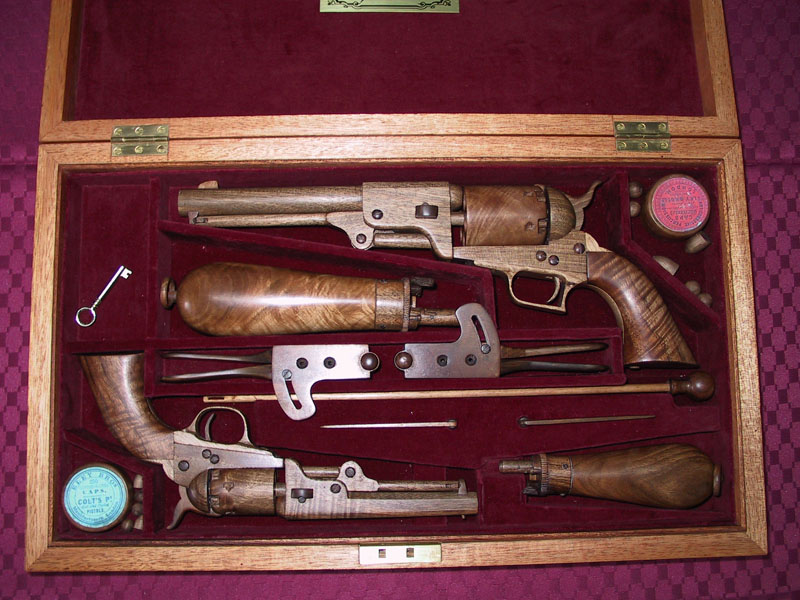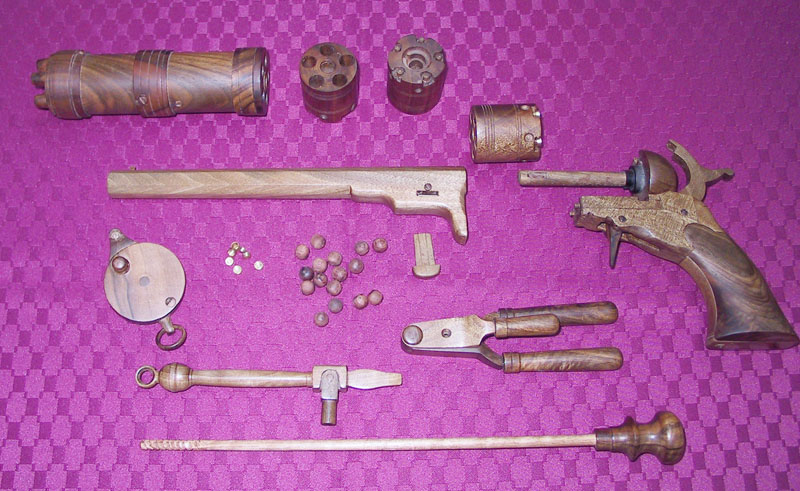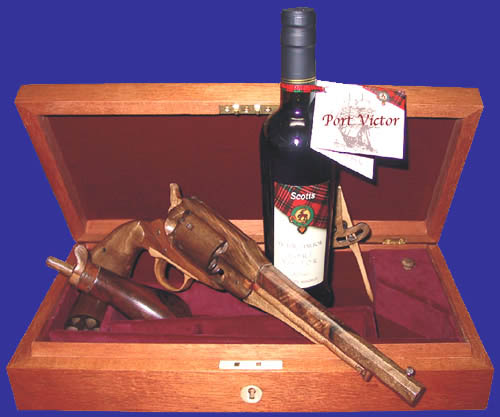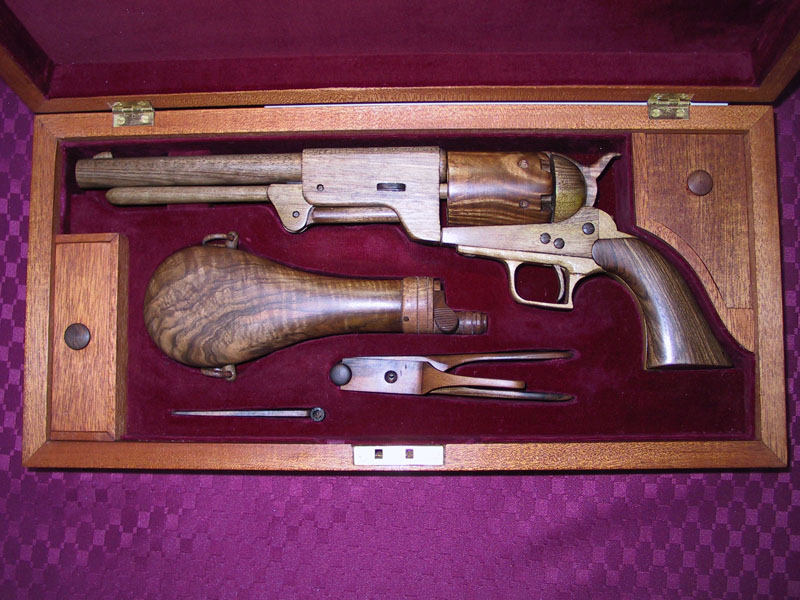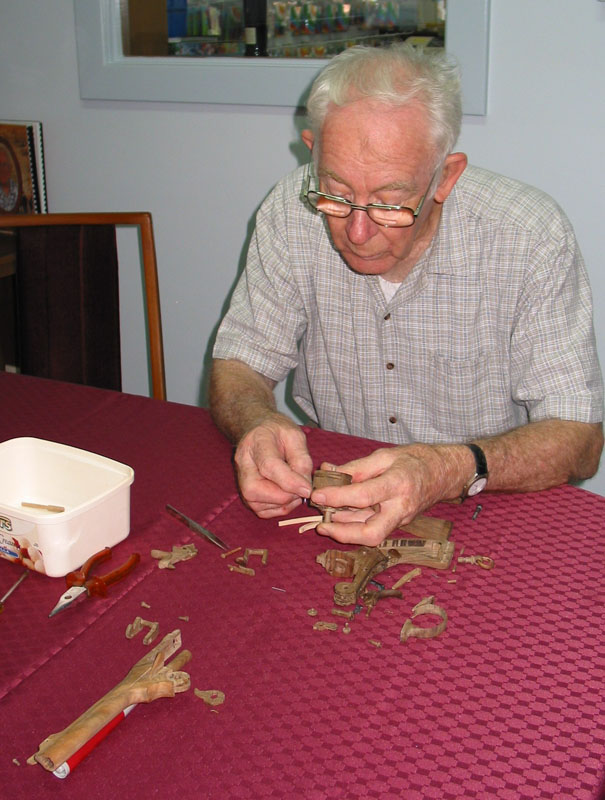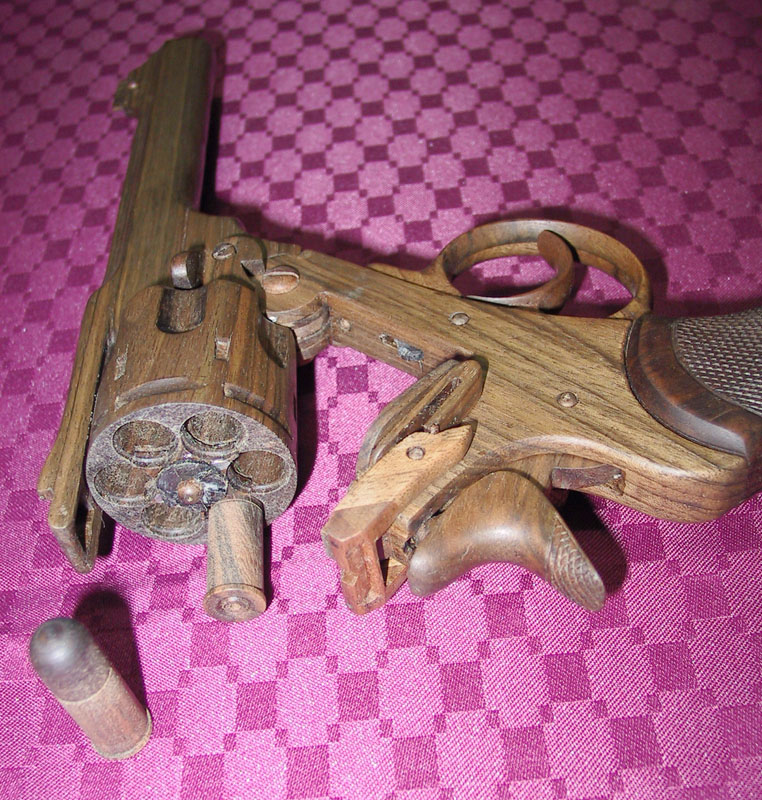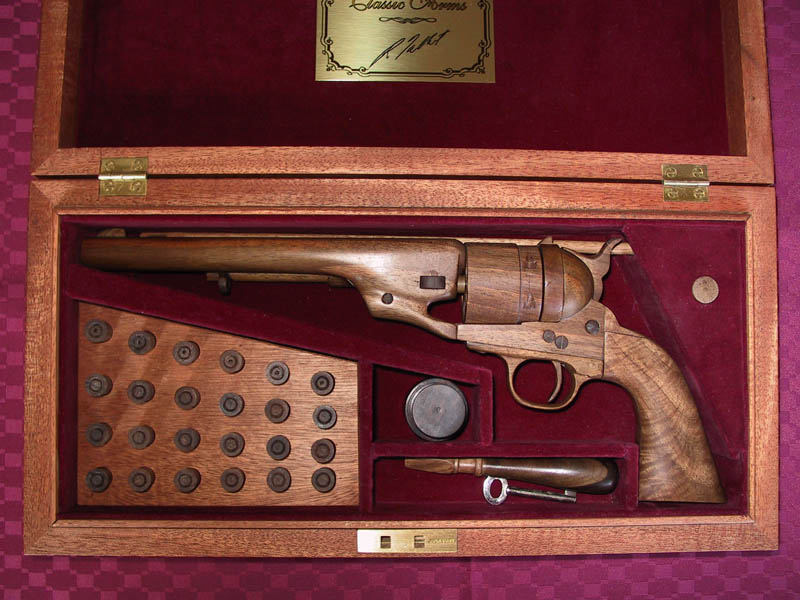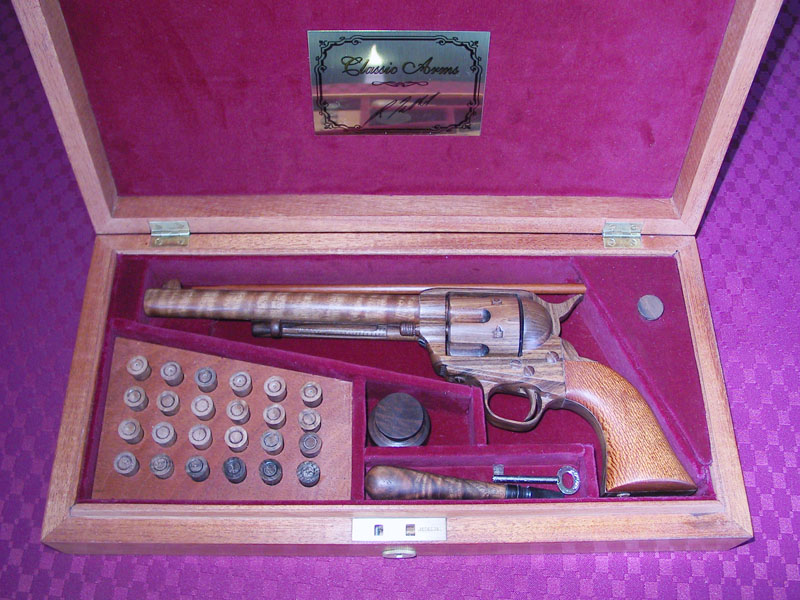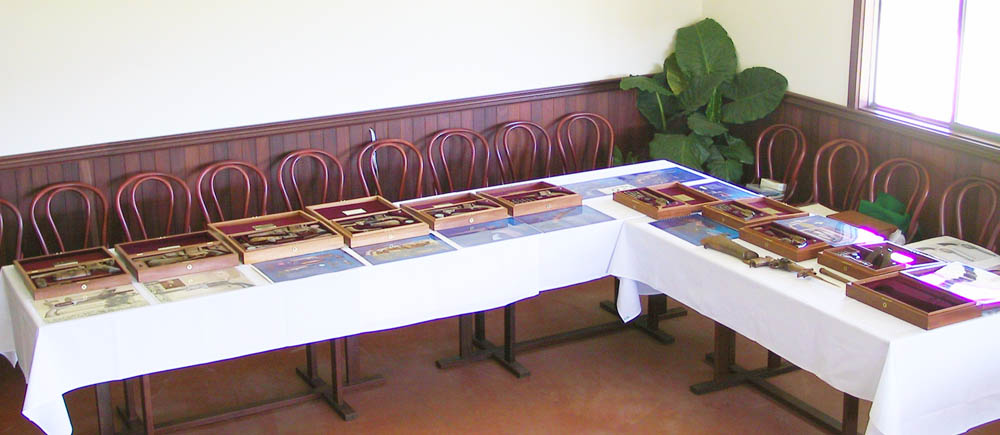Historic Firearms Carved From Wood
Robert A. Talbot displays a few of his fine wooden replica revolvers. Though models, these guns consist of many of the same component parts as the original, but duplicated in wood. Even most of the springs are wooden, and the guns function just like their original counterparts—with the exception of actually firing. In this photo, Mr. Talbot displays a Colt Walker revolver in his right hand, and a Remington in his left. (Photo courtesy of Ken Lewitzka.)
About Robert A. Talbot
The following autobiography by Robert Talbot was published on the website of collector Ken Lewitzka, and reproduced here with his permission. Mr. Lewitzka knows Mr. Talbot personally, and also owns a number of his fine pieces. All photos are courtesy of Ken Lewitzka.
I was born October 23, 1925 in Sylvania, New South Wales, Australia, on the foreshores of Botany Bay, where the Christmas tides flowed into the bottom of our land.
My Uncle Jack lived next door with my grandparents. He was a very good woodworker, mechanic, bricklayer and builder. He built wooden model sailing boats for us three boys to sail on those waters. He built many toys for us such as aeroplanes, cars and cowboy guns. The guns were simple wooden shapes with a cotton reel for a cylinder and a nail for a trigger.
Because of my love for all things mechanical, it wasn’t long before I was following in his footsteps. Times were hard, material and tools were scarce. I learnt to make my tools and to salvage timber that floated across the Bay from the boat builder’s yards, and so, managed to turn out reasonably satisfactory models.
Boyhood friends were of the same making and we encouraged each other. One of them, Roy Craven, and I became almost inseparable and very competitive. We built boats, sailed and fished the beautiful waters of Botany Bay and Cronulla, as well as building model aircraft. He is a very talented man and he still designs and builds boats. He and his sons hold many records in offshore power boat racing craft that he built. Roy is a lifetime friend.
We both attended Hurstville Central Technical Trade School where we became skilled in wood and metal working, fitting and turning, as well as trade drawing. Our masters were fine teachers, encouraging and demanding high standards, and we responded well. In a semi-rural area firearms were commonplace. I had joined the Rifle Cadets at thirteen, training with and shooting the service rifle.
Some of Mr. Talbot’s early models were non-functional replicas like the ones shown here. As his skills grew, Robert made it his goal to reproduce the guns as accurately as possible, remaking every single piece of the original in wood.
As was common practice, I took it home with me after parades and target practice. We learnt self reliance and responsibility at an early age. My interest in firearms and aircraft were now firmly set, and along with my love of wood working became a combined lifetime pursuit. By this time I was back to my wood work and guns, collecting and restoring antique and collectable firearms.
I joined the Metropolitan Rifle Club and shot full bore rifle at the Dean Range. Not satisfied with my rifle’s performance, I rebuilt it! As my work came into demand I built rifles for other shooters, many of whom achieved success around the world.
By this time I had moved to the power tool industry as the Service Manager of David Trembath Agencies, whose reputation in this trade was very high, and I remained for the next 10 years. Back problems forced me to give up shooting and seek a different style of employment.
I went back to producing wooden model handguns. They were accurate in detail, had some working features and attracted much interest. One was even featured on the front page of The Advertiser, the major Adelaide newspaper.
A pair of finished Colt Navy revolvers. This is the only set of matching revolvers in the collection.
They were very labour intensive, so I stopped making them when I started my own business restoring antique firearms, stock-making, and building custom rifles and shotguns. My work was in demand and many fine arms were produced. One set of rifles were used to hunt in Africa and many shotguns and rifles have done well in competition.
In the last couple of years before retiring and coming to Victor Harbor, I built some more of the wooden guns on request from old customers. I also wanted to use up the walnut off-cuts that I could not bear to throw away. The demand for them continued until I officially retired from my business.
Robert also made the famous Colt Peacemaker revolver. This six-shooter was most often seen being carried by cowboys and gunfighters in the old Westerns.
After trying to retire to idleness, I began to toy with the idea of concentrating on revolving arms and making them fully working. I even thought it might be possible to make wooden springs. After a challenge from a friend, followed by lots of failures, the first fully functional model was produced—and with further refinements the techniques developed became practical.
Now at 77 years of age I am still capable of setting myself high standards. I am now producing work that even I could not imagine was possible in the past.
With the outstanding work of my computer graphic friend Ken Lewitzka, we are now able to realize my ambition of displaying my pieces to far more people. He tells me that he has scoured the internet, and has not been able to find anything similar. We believe this work is unique, and to me this is exciting beyond my wildest dreams… well, beyond the ones I had as a boy when I picked up my penknife and started to whittle my first cowboy gun.
—Robert A. Talbot
Mr. Talbot displayed this revolver, and many others, at the Victor Harbor Winery in South Australia. Robert reproduced every detail down to the rifling in the barrel. He had to make special tools for each revolver, as the models are both right and left handed, and of various calibers. Robert does the rifling at the start of each project, before too much work has been done, because he’s broken some barrels while tooling the rifling in the timber.
Ken Lewitzka Helps Robert Publicize His Work
By Ken Lewitzka
I first met Mr. Talbot when he came into our copy shop with some photos he wanted to enlarge so he could make up a display book of his hobby. I could not quite understand his craft from the photos, so asked him to bring in a piece of his work for me to digitally photograph, so that I could prepare a quality colour laser print. Well, as they say, seeing is believing. Mr. Talbot returned with his 1851 Colt Navy pistol in an elaborate display case.
The craftsmanship, the detail, and the colour and grain of the timber were something to behold. I immediately said, “I want one!” And then asked if he could also do an 1863 Remington. Mr Talbot agreed, and explained that at that time he had few orders, so it could be completed in about four months. It was evident that a great deal of work went into each piece, and that took time.
About a week after that, Mr. Talbot brought in a 1915 Webley for me to photograph. I was totally amazed by his skill at making a fully working wooden firearm…with the exception that it did not shoot bullets! The detail is astounding: a functional wooden spring; rifling down the barrel; checkering on the handgrip; wooden bullets in the cylinder; and even timber screws holding the parts in place. These marvelous pieces have to be seen, touched and handled like a real gun to be believed.
Having seen the Webley, and being aware that Mr. Talbot did not have many orders from his hobby, I asked if he could produce one for me as well. Two days later we sat down and discussed his making a full set of historical classic firearms for me. It would be like re-telling the history of firearms through a series of working wooden replicas.
The concept of a collection had evolved, and mine will become the only full collection of its kind in the world. I see on the internet that there are plenty of wooden toy guns available, but not accurate working replicas in wood.
Over the years R. A. Talbot has built many fine firearms including competition rifles, shot guns made for the 1958 Commonwealth Games, and even a rifle that won prizes in the Bisley competitions in England. I am delighted to have met him and thrilled that he agreed to undertake such a project.
After many hours on the internet and many emails to lots of clubs, collectors and other people around the world with an interest in classic arms or related topics, I believe that Mr. Talbot’s replicas are the only ones of their kind. This set will be a truly unique collection, and a tribute to his dedication and skills as a gunsmith and fine craftsman.
—Ken Lewitzka
Mr. Talbot’s Work on Display
In conjunction with the Tom Quilty Gold Cup Ride in October 2004, the KD Lewitzka Collection of Robert Talbot’s wood-crafted classic arms was put on exhibition at the Victor Harbor Winery, South Australia. This was the only public exhibition of Mr. Talbot’s entire collection.
Robert Talbot was also featured on the ABC “Collectors” program on April 7, 2006.
View more photos of Robert Talbot’s impressive scale wooden firearms.

